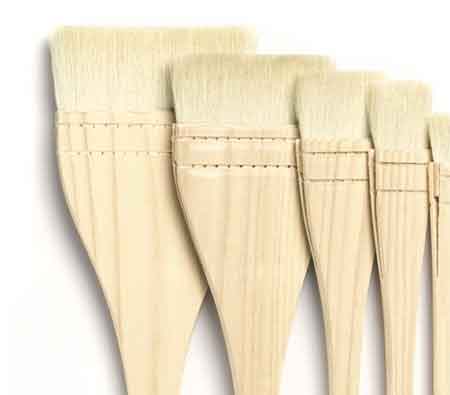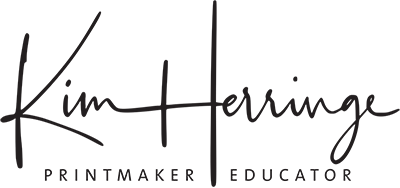Student Cyanotype Resources
This page shares information that I hope will encourage you to continue exploring the beautiful blue world of cyanotype well after our workshop day.
Bookmark this page in your browser so you can keep referring back to it.
When looking for something specific, I encourage you to shop around for different pricing and sales.
And please let me know if you think I’ve left anything out!
I’ve categorised the resource information below. Click on each toggle to read and click through on links that interest you. Each link will open in a new window, so you won’t lose this page.
Bookmark this page in your browser so you can keep referring back to it.
And please let me know if you think I’ve left anything out! 🙂
CYANOTYPE CHEMICALS
The UV light-sensitive cyanotype soution is a mix of equal parts diluted Ferric ammonium citrate (soluiton A) and diluted Potassium ferricyanide (solution B).
- Solution A – diluted Ferric ammonium citrate (green) > 25g / 100ml water*
- Solution B – diluted Potassium ferricyanide > 10g / 100ml water*
- Distilled water is ideal. I use tank water (rain water). Town water will work, but consider leaving it in a bowl overnight to let the chlorine evaporate out before making your own solution.
BUY KITS ONLINE
You can buy ready-make kits online. Both Gold Street Studio and Vanbar Imaging sell cyanotype kits.
- 100ml kit – goldstreetstudios.com.au/product/cyanotype-kit-100ml
- 200ml kit – goldstreetstudios.com.au/product/cyanotype-kit-200ml
- 200ml kit – vanbar.com.au/catalogue/product.php?id=115339
I have seen Jacquard kits at Eckersley’s where the dry powder is in a bottle and you add water. You can also buy prepared paper and fabric kits.
*I use tank water (rain water) when I mix my dry chemicals. The recommendation is to used distilled water. You can make your own distilled water, or buy from some supermarkets and hardware stores. People do use tap water – but maybe make a small batch and test to make sure you get the results you expect. Tap water has additives, and different councils or water plants may have different water compositions. It should be ok – but test first. If using tap water – leave it in a bowl overnight to let the chlorine evaporate out of it before mixing with the dry chemical.
BUY KIT FROM ME
I only sell kits to students. At this stage you will have to pick up from Maleny though as I don’t post the kits. I’m looking for a way to send dry chemical to make it easy for postage. Kits are available subject to my chemical supply.
- 200ml kits (100ml each of Solution A and B) – $30
- 400ml kits (200ml each of Solution A and B) – $45
BUY RAW CHEMICAL
If you are wanting to create larger quantities of the solution I would recommend buying the raw chemical and make your own. I buy my raw chemical from Vanbar Imaging. Click through to their online shop and search for the chemicals. Then you can choose the quantity you want. I buy 1kg containers – but you can buy smaller lots of 100g and 500g of each chemical. Note – you use more than double FAC per 100ml, so you could consider buying 500g of PF and 1kg of FAC.
- FAC – Ferric ammonium citrate (green) > 25g / 100ml water
> as at June 2022 1kg from Vanbar is approx $50 - PF – Potassium ferricyanide > 10g / 100ml water
> as at June 2022 1kg from Vanbar is approx $88

HAKE BRUSH
The brushes I use to coat my papers with cyanotype sensitiser are Hake brushes. Most art shops sell them.
They are a plain handled wide flat brush made with soft goat hair.
I sell them from the studio, when I have stock:
- small 1″ brush – $6
- long 2″ brush – $8
You can also use a foam brush, credit card or any soft-bristled brush.
CYANOTYPE REFERENCE BOOKS
I have written a review of sorts for some of the books listed below. Click here if you’d like to read about the books and see some of the inside pages. I also note pricing and include links where you can buy them. Below are printed books I am fortunate enough to have in my library. Some are out of print, some are readily available:
Cyanotype – The blueprint in Contemporary Practice by Christina z. Anderson
Search for the name on Google to find the online bookstore with the best price.
Cyanotype Toning: Using Botanicals to Tone Blueprints Naturally by Annette Golaz
Search for the name on Google to find the online bookstore with the best price.
Sun Gardens – Cyanotype by Anna Atkins by Larry J Shaaf
Again, Google the book name. This book is out of print at the moment, but hopefully a new print run will be done sometime soon.
Sea Signatures by Marianthi Lainas is the book I showed you that arrived the other week – cyanotype prints working with the movement of water. It is a beautiful and inspiring book. The cost is £35.00 + shipping.
This ebook is an excellent resource and excellent value for money:
Blueprint to Cyanotype – Exploring Historical Alternative Photographic Process by Malin Fabbri and Gary Fabbri
You can buy this as a printed book or eBook. I have it as an eBook and it s a great starting point. Click the link above to buy the eBook directly from the authors for US$18.
I encourage you to let your fingers do the tapping and see what else you can find online. There are numerous online blog posts and articles discussing the process.
CYANOTYPE ARTISTS
This is the list of artists I gave you in the handouts, plus a few others. Where possible i have included both their websites and social media links.
Artist: Linda Clark Johnson
Website: lindaclarkjohnson.com
Facebook: facebook.com/lindaclarkjohnson.art
Instagram: instagram.com/lindaclarkjohnson
Artist: Nadine Werner
Website: nadinewerner.com
Instagram: instagram.com/buchundpapier
Artist: Christine So
Website: www.saatchiart.com/christineso
Instagram: instagram.com/christinesogallery
Artist: Caroline Hamilton Wisler
Facebook: facebook.com/carolinewislerartist
Instagram: instagram.com/carolinewisler
Artist: fruma markowitz
Website: frumamarkowitz.photo
Facebook: facebook.com/frumamarkowitz.photo
Instagram: instagram.com/frumamarkowitz.photo
Artist: Jill Welham
Website: mirrored-images.co.uk
Facebook: facebook.com/MirroredImagesArt
Instagram: instagram.com/mirroredimagesart
Artist: Julia Whitney-Barnes
Website: www.juliawhitneybarnes.com
Instagram: instagram.com/juliawhitneybarnes
Artist: Jocelyn Matthews
Website: www.jocelynmathewes.com
Artist: Cholena Drew-Hughes
Website: cholenadrewhughes.com
Facebook: facebook.com/CholenasArt
Instagram: instagram.com/cholena_artist
Artist: Marianthi Lainas
Website: marianthilainas.com
Facebook: facebook.com/openspaceimages
Instagram: instagram.com/marianthi_lainas
Artist: Erin Patton McFarren
Website: erinpattonmcfarren.weebly.com
Instagram: instagram.com/epattonmcfarren
Artist: Will Creech
Website: www.cyanotype.studio
Instagram: instagram.com/cyan_o_type
SOCIAL MEDIA
Instagram and Pinterest are my biggest social media inspiration sources. There is so much to see online!
Following these Instagram tags to see who is doing what with this delicious process:
- #cyanotype
- #wetcyanotype
- #botanicalprint
- #alternativephotography
I have a cyanotype Pinterest board that can be a good place to start your trip down the Pinterest rabbit hole. You will see a few of my photos at the top – scroll past them then explore other photos. Many links will lead to people sharing tips and resources about how they approach the process.
EXPOSURE TIMES
This link will take you to the worldwide survey where “Experienced cyanotype printers share their knowledge in this big survey of cyanotype exposure time from all over the world.” www.alternativephotography.com/the-big-cyanotype-exposure-survey-results
EXPLORE WET CYANOTYPE
Wet cyanotype is sooooo exciting. Here are a few other instagram accounts of people exploring this aspect of the process:
- Fruma Markowitz > instagram.com/frumamarkowitz.photo
- Linda Clark Johnson > instagram.com/lindaclarkjohnson
- Christine So > instagram.com/christinesogallery
- Liz Harrington > instagram.com/_lizharrington
- Marianthi Lainas > instagram.com/marianthi_lainas
- Marina Sabater > instagram.com/marinacyano_
- Jill Welham > instagram.com/mirroredimagesart
PAPER
The paper we printed onto was a mix of watercolour paper and printmaking papers:
As you start to do your own research around the process you will see many people using many different papers.
Any paper that will handle immersion in water will work for cyanotype. Experiment and play with different papers. White, coloured, recycled, handmade.
Results may vary is papers are sized and buffered – have a play with anything you have on hand, or look back on the reference handouts where I listed the papers we used, or ask Google.
Below are links to a new series of articles talking about paper. Beautiful, delicious, multi-purpose paper, with a focus on Printmaking paper:
- Paper Part 1 – What is Printmaking Paper
- Paper Part 2 – My Favourite Printmaking Papers
- Paper Part 3 – Storing Printmaking Papers (and answers to other questions you didn’t know you needed to know)
- Paper Part 4 – All About Paper Sizes
This is the paper I like to use specifically for wet cyantoype – Clairefontaine Fleur De Cotton Printmaking Paper. You can buy it in sheets of rolls. If you are interested in buy some, I can get pack of 10 sheets for approx $65-$70. If you would like to buy some, let me know and I can confirm pricing for you.
Canson Montval 200gsm watercolour paper is the padded paper you coated yourself after lunch. It is a pH neutral paper that gives me consistent good results.
And this link will take you to a Sydney-based online store selling lace papers (from Amazing Paper in Sydney). I have bought these papers from Oxlades and The Art Shed in Brisbane
TRANSPARENCY FILM
This is the transparency film I use on my laserprinter and inkjet print for printing transparencies for cyanotype – Eziscreen Artwork Transparency
I have bought from Office Works and Art Shed Brisbane and I think a newsagent. Eckersleys sell it, and other art stores. Do a Google search for the product to find the best price option.
BUBBLES
This is the recipe that makes rather robust bubbles – happyhooligans.ca/homemade-giant-bubbles
The recipe makes a large quantity. I reduced the quantities down make approx 1 cup of bubble mix.
At the very least you will want to mix glycerine with water and dish washing liquid. I use a Jamie Oliver ‘dash of this and swish of that’ when making up a bubble mix.
RENAISSANCE WAX
This is the wax that I use to protect some papers in my bookmaking. I generally use this wax for papers where I think the colours from one paper may rub to another paper. I found a big range in price for this product, depending where you buy from, so shop around for the best price online.
- Renaissance Wax – 200ml – approx $40
- Renaissance Wax – 3kg – approx $175
OTHER RESOURCES AND INFORMATION
Mandy Barker is “Visualising Britain’s fashion waste problem with cyanotype photography” – an interesting 7-minute video on YouTube.
World Cyanotype Day – www.worldcyanotypeday.com
Alternative Photography – www.alternativephotography.com
MOUNTING TO PANELS/BOARDS
Below is a series of videos from one of my online workshops that demonstrate my process for mounting paper artwork to timber panels or boards. I use this process to mount then sell some of my cyanotype prints.
These are the boards I buy, from The Sydney Art Store. Most art stores sell boards that you can use.
I use the Matisse Mid-viscosity binder medium, but you could use an acid free PVA glue, to stick the paper to the board. I like to use the satin varnish.
Then Micador ‘For Artists’ spray varnish to seal the work.
WANT TO DO THIS ALL OVER AGAIN and again and again and … ?
I took this workshop online in January. Everything we covered in our in-person workshop is covered in the online workshop, plus a bit more – so you can refer back to it when ever you want or need to, in your own space and time. There is over 2 hours of video content, made up of 50+ videos.
Access to the online workshop is normally $97, being granted for the lifetime of the course. For students who have already attended this workshop in-person, access is $47.
Click here for full details about the online course or fill in the enrolment form at the bottom of this page and I will email your portal login details.
RECIPES
Depending on the day, you will have (hopefully!) enjoyed a homewade orange almond cake, or almond biscuits. I get asked a lot for the rcipes for both, so here they are:
- This is the recipe I used to make the orange almond cake. I make a few variations – swapping oranges for lemons or mandarins, and sometimes adding dark chocolate pieces. YUM.
- This link contains the recipe for the almond biscuits. Enjoy 🙂
I have created a private Facebook group ONLY for people who have attended my workshops. The idea is you can ask me questions, we share work, and I’ll share resources and information. Click the button below to join the conversation …




